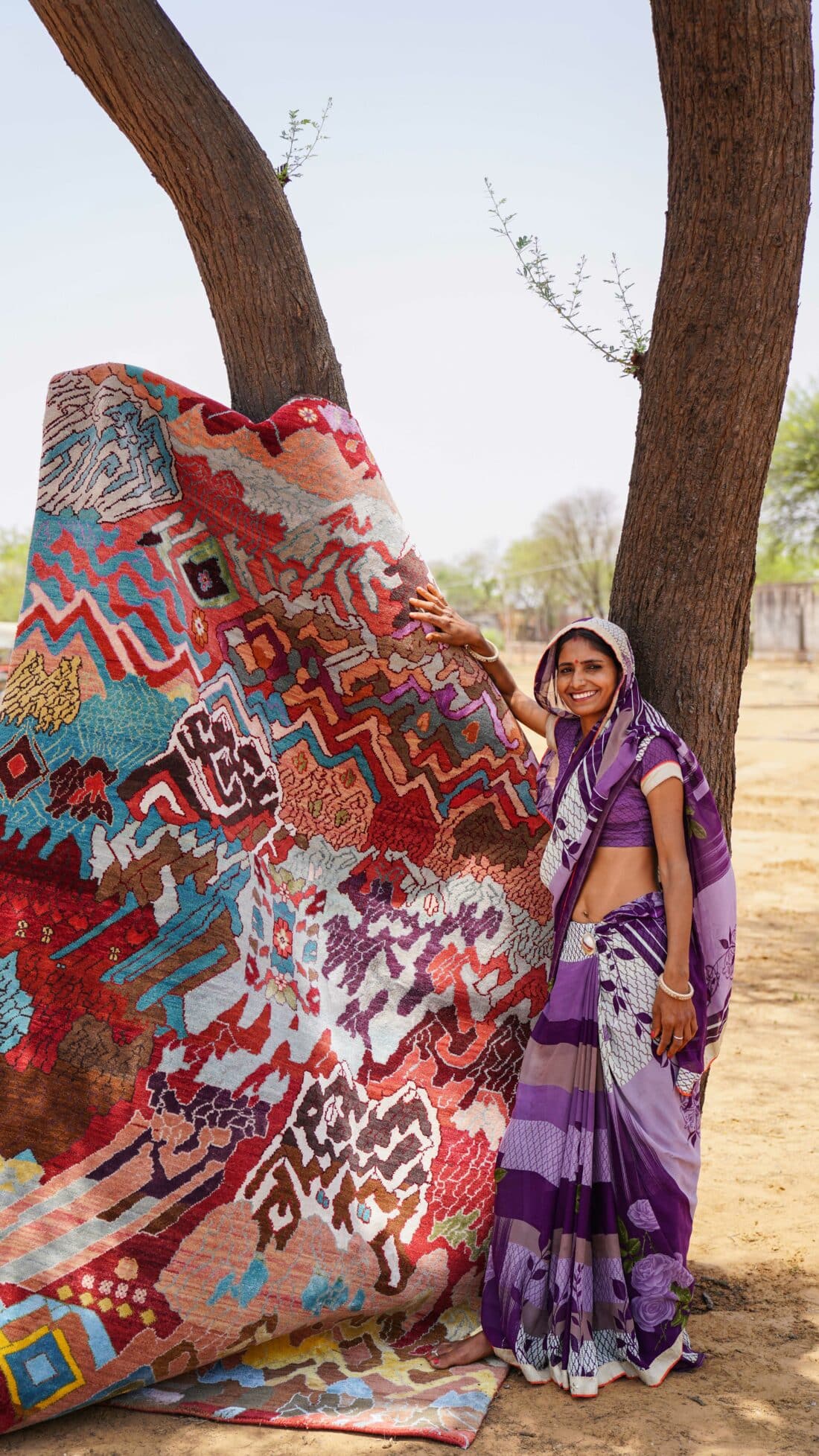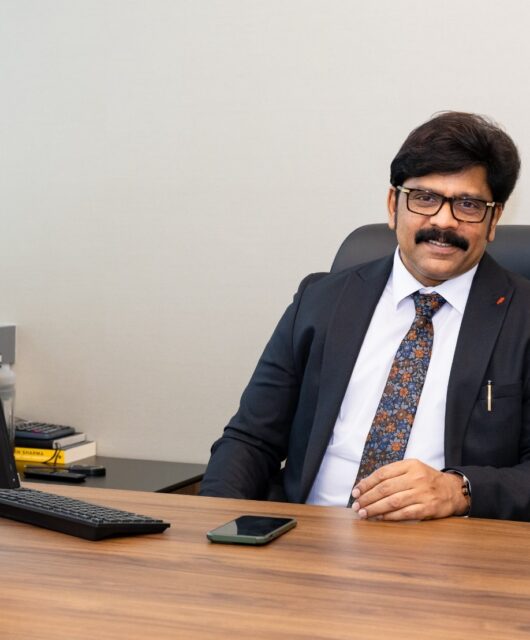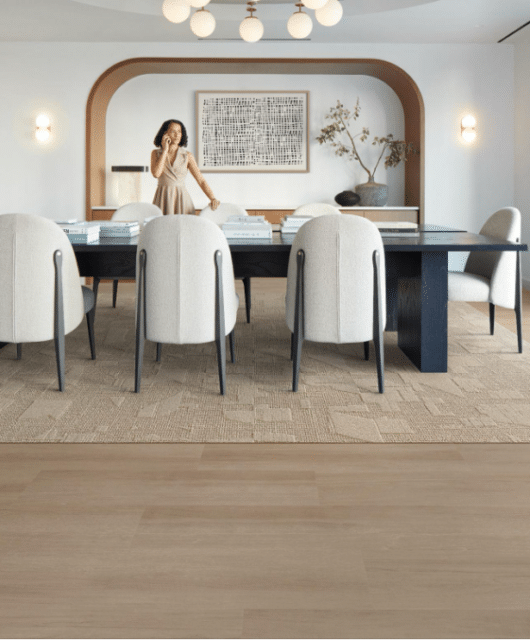 The founder of Jaipur Rugs, N.K. Chaudhary, discusses the company’s history, evolution over time, popular weaving techniques, and future growth goals.
The founder of Jaipur Rugs, N.K. Chaudhary, discusses the company’s history, evolution over time, popular weaving techniques, and future growth goals.
By Roma Arora
Can you give us a brief history of your Jaipur Rugs?
I gave up a bank job and borrowed Rs.5000 from my father to start Jaipur Rugs in 1978. The journey began with two looms, nine weavers and one two-wheeler in Rajasthan. We started with the age-old art form of handmade carpets and revolutionised the carpet industry by creating an entirely new business model- working directly with artisans and empowering them and their communities with a sustainable livelihood.
In 1986, we started to export our rugs directly thus taking the first step towards my dream of connecting artisans to global markets. In the year 2000, a sister company was formed to distribute the products in the American market and in the year 2004, we started Jaipur rugs Foundation for the betterment of our artisan community. In the year 2016, we started selling directly to the end consumer and opened our first retail store in Delhi, India.
We extended our operations and began partnering with designers and artists from all over the world as Jaipur Rugs earned recognised for its quality and artistic excellence. This resulted in the development of innovative rug designs that combined ancient techniques with contemporary aesthetics, appealing to a wide spectrum of customers.
Today, the company has 7000 looms and is working with over 40,000 artisans across the country (out of which 90% are females). Jaipur Rugs today has eight mono brand stores in India and abroad and has a worldwide distribution network.

How has the business evolved over the years?
Since its establishment in 1978, the company has grown in terms of size, reach, product range, and its approach to sustainability. Here are some key ways Jaipur Rugs has evolved:
- Artisan empowerment: Jaipur Rugs has always focussed on empowering local artisans by providing them with opportunities to showcase their craftsmanship. Initially, the company started with a few weavers in rural Rajasthan. However, over the years, it has expanded its network to include thousands of skilled artisans from remote villages across India.
- Design Innovation: The brand has continuously embraced design innovation to cater to evolving market demands. While initially focused on traditional designs, the company has collaborated with renowned national and international designers to develop contemporary collections that blend traditional craftsmanship with modern aesthetics
- Product range diversification: Over the time, we have expanded our product range beyond carpets and rugs. We now offer a wide array of home textiles, including pillows, poufs, throws, and dhurries.
- Global reach: We have established a strong network of partners in various countries and also have an e-commerce platform. This expansion has not only increased our market reach but also created opportunities for the artisans to showcase their skills to a broader international audience.
- Sustainable practices: Recognising the importance of sustainability, we have incorporated environmentally friendly practices into our operations. Jaipur rugs as a responsible and eco-conscious brand emphasise on using sustainable and natural materials to minimise ecological footprint.
- Technology integration: The company utilises modern software systems for design development, inventory management, and supply chain optimisation. We also have an in-house application which allows our artisans to connect with us on real time basis. This integration has allowed us to reduce lead time, and enhance quality control.
How do you select your artisans, and where do they come from?
Currently, we are working in five states of India and we follow a meticulous process to select and identify the artisan clusters in rural areas across India. These clusters are typically located in villages known for their weaving traditions and skilled artisans. The company scouts for regions where traditional weaving techniques are still practiced and where artisans can benefit from sustainable livelihood opportunities. We then evaluate the weaving skills, abilities of the artisans and quality of their work and most important is their willingness to learn and adapt to new trends.
We lay a major focus on skill development and proper training as a company, and we have established many programmes for artisans to improve their weaving skills and introduce them to new and current design concepts, quality standards, and client preferences. These training programmes ensure that the artisans can make carpets that match the high standards and commercial expectations of Jaipur carpets.
Our fair-trade practises, long-term relationships with our artisans, including regular job opportunities, fair compensation, and access to healthcare and education facilities for them and their families, build a spirit of partnership and mutual growth.

How crucial is it to choose the proper carpet for your space? What factors should one consider before selecting a carpet?
Choosing the right carpet for your room is critical since it may have a big impact on the overall aesthetic, comfort, and functionality of the space. Before purchasing a carpet, several elements should be addressed, including durability, appropriate material, comfort, upkeep, placement, function, and design.
Who are your target audiences?
Our rugs are designed to add warmth, texture and visual appeal to spaces such as living rooms, bedrooms, dining areas, waiting areas, hallways and we cater to wide variety of people like homeowners, designers, architects, hotels, resorts, restaurants, and art enthusiasts.
What is the most popular weaving technique? What are the most commonly used materials in your work?
There are four types of weaving techniques used by Jaipur rugs hand-knotted, hand-tufted, hand loom, and flatweaves:
Hand knotted: On a loom set up with warps, an artisan ties individual knots on each warp thread, going line by line. Once a line is complete, it is locked in place with a thread of weft, before the next line of knotting begins.
Hand tufted: Using a tufting gun, an artisan tufts yarn into a fabric that is outlined with a design. The outline guides the artisan to know which colors go where, to create the rug’s final design.
Hand loom: This form of weaving is very similar to textile weaving on a handloom. The warp and weft are much thicker to create a thick fabric, the rug’s yarn is passed through in between the interlocking
Flatweave: A flatweave is made entirely of interlocking warp and weft threads, the colours are based on the thread and the design is based on the different styles of interlocking.

In today’s environment, how significant is e-commerce?
E-commerce in today’s world has become an integral part of the modern business landscape. Its convenience, global reach, and transformative impact make it a significant force shaping the way we shop and do business today. It has eliminated geographical barriers, allowing businesses to reach customers worldwide. Online platforms enable businesses to expand their customer base beyond their local markets and tap into international markets. This global reach opens up new opportunities for businesses and facilitates cross-border trade. Companies that fail to embrace e-commerce may struggle to compete effectively in today’s market.
What can you tell us about your most recent collection?
Recently we have launched three new collections in collaboration with Ad 100 Designer Pavitra Raja Ram titled “Majnun”, Postorganic with Maria Laura Irvin and Woven Gems with Jocelyn Burton.
Majnun is rooted in the history, geography, and storytelling of carpets that originated in Persia, China, and India and made their way through time to a global audience around the world. The designs include a traditional Shikargah from the stately English homes in the 18th and 19th centuries and hypnotic tantric tiger rugs of Tibet, re-interpreted with traditional motifs. A traditional “Bid – Majnun” or weeping willow motif reinvented in the manner of a Chinese scroll painting and the folk tradition of the Afghan war carpets, adapted to our own Indian colonial narrative.
Woven gems: The collection features 11 striking designs, with a limited run of only 10 pieces each. Jaipur Rugs and Jocelyn Burton chose the Tibetan and Persian construction techniques to suit each of the designs, applying different weaves to confer a distinct range of textures and tactility.
Post organic: The Postorganic collection, designed instead by Studio Irvine, is inspired by architecture and the colours of the earth and nature, echoed in textures and materials. In an interplay of colours and patterns, an attempt is made to invite the viewer to contact the surface of the rugs to expose their tactile perception.
What are your expansion plans?
We want Jaipur rugs to be a timeless and global brand, A name synonymous with kindness, love, luxury, design, and aesthetics. Every region is unique and a one size fits all approach may not be effective. Flexibility adaptability and ongoing evaluation will be essential as we open new stores in different locations. Our initial focus in the MEA region will be on our Dubai store, leveraging locations and the opportunities it offers. Simultaneously, we are actively seeking favorable locations across the world to expand our presence. With a vision of opening 30-35 stores within five years and reaching approximately 100 stores within the next 10 years, we are committed to aggressive growth and establishing a strong footprint globally.







